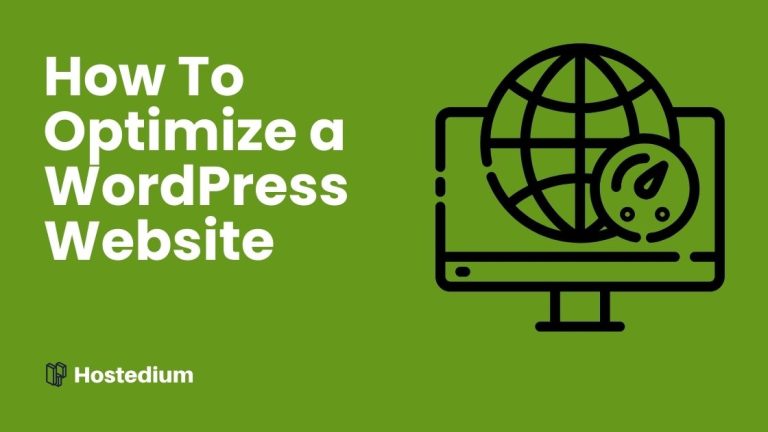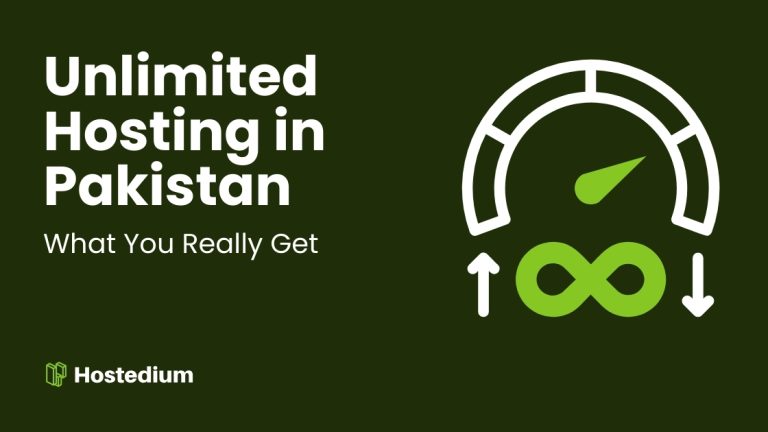Key Takeaways
- Speed target: under 3 seconds; closer to 2s is ideal.
- Uptime target: ≥99.9% standard; ≥99.5% minimum for SMEs.
- Measure smart: test with GTmetrix and PageSpeed Insights; monitor with UptimeRobot.
- Tech stack: SSD, LiteSpeed/NGINX, HTTP/2/3, and server-level caching matter most.
- Security & trust: always enable SSL (e.g., Comodo SSL at PKR 3750/year).
- Right-sized plans: Budget (PKR 599/month), Business (PKR 725/month), and Unlimited (PKR 850/month) can all perform well when configured properly.
- Upgrade only when needed: move up tiers if you consistently hit resource limits or see peak-hour slowdowns.
What does “hosting performance” actually mean?
Answer: It’s how fast pages load (speed), how consistently your site is online (uptime), and how well the platform holds up under pressure (reliability).
Evidence: These three signals directly shape user experience, SEO visibility, and revenue outcomes. A crisp framework is to measure page load, track uptime externally, and verify stability during traffic spikes.
Why does hosting performance matter in Pakistan?
Answer: Slow or unstable sites bleed clicks, trust, and conversions.
Evidence: Google has repeatedly shown mobile speed correlates with better outcomes; even small speed improvements lift conversions. Portent’s large-scale study found pages loading in 1 second achieve roughly 3× the conversion rate of pages at 5 seconds. (Google Business, Portent)
How fast should a website load in Pakistan?
Answer: Aim for <3s on typical connections; ~2s is a strong benchmark.
Evidence: Hardware (SSD), web server choice (LiteSpeed/NGINX), caching, and data-center proximity are the main levers. Measure with GTmetrix and PageSpeed Insights; run multiple tests at different times and average the results. (gtmetrix.com, PageSpeed Insights)
Light note: Caching is like preheating an oven—do it once, and everything that follows is quicker.
What uptime is “good enough”?
Answer: 99.9% is the practical standard; 99.5% is the minimum for SMEs. Each 0.1% drop adds hours of downtime annually.
| Uptime | Downtime / Year | Verdict |
|---|---|---|
| 99% | ~3.5 days | Too low |
| 99.5% | ~1.8 days | Bare minimum |
| 99.9% | ~8.7 hours | Standard |
| 99.99% | ~52 minutes | Excellent |
Evidence: Uptime Institute’s analyses show outages carry material business cost; minimize them with sound infrastructure and monitoring. (Uptime Institute)
How to compare real-world speed between hosts
Answer: Keep everything the same except the host.
Method you can copy:
- Spin up the same WordPress theme and plugins.
- Track TTFB, Largest Contentful Paint, and Fully Loaded Time.
- Test from Asia locations in GTmetrix and repeat at different hours.
- Change only the host to keep the test fair. (gtmetrix.com)
Practical tip: Huge sliders and uncompressed images skew results more than hosting does—optimize assets first.
Does shared hosting perform well enough in Pakistan?
Answer: Yes—for most blogs, portfolios, and SME sites.
Evidence: With SSD + LiteSpeed + caching, well-configured shared plans comfortably handle ~10k–30k monthly visits (assuming sensible themes and images). If you approach resource limits, step up a tier; don’t jump to complex setups prematurely.
Hostedium plan fit (prices auto-print via ACF):
- Budget Hosting — PKR 599/month → student projects, portfolios, small blogs.
- Business Hosting — PKR 725/month → SMEs needing steadier capacity and email.
- Unlimited Hosting — PKR 850/month → growing sites with larger storage/bandwidth needs.
For fundamentals, see our pillar: Web Hosting in Pakistan – Complete Guide.
Reliability is more than uptime
Answer: True reliability = uptime + consistent speed + responsive support + backups + security.
Evidence:
- Support: First-response time and actual resolution speed both matter.
- Backups: Automated daily/weekly backups and quick restores reduce recovery time.
- Security: Always enable SSL (see SSL Certificates), maintain patching, and use a firewall.
The hidden cost of poor performance
Answer: Lost leads, wasted ad spend, refund pressure, and SEO decline.
Evidence: Uptime Institute’s research ties outages to measurable financial and reputational impact; even short incidents are costly for transactional sites. (Uptime Institute)
Simple thought experiment: If slow pages cost you 2 leads/day, that’s ~60/month—far pricier than right-sizing hosting or compressing images.
Monitor uptime (and keep vendors honest)
Answer: Use an external monitor for independent checks.
How: Set up UptimeRobot, choose 5-minute (or faster) checks, and enable email/SMS alerts. Keep a simple log of incidents (date, duration, cause, resolution).
Does data-center location matter?
Answer: Yes—closer origins reduce latency. A CDN helps static assets globally, but it won’t mask a slow origin (e.g., heavy queries). Verify with multi-location tests and choose regions aligned to your audience.
Guideline: Fix origin bottlenecks first; use a CDN as an accelerator, not a bandage.
Practical checklist: Evaluate a host’s performance
- Uptime SLA: ≥99.5% with service credits for breaches.
- Stack: SSD, LiteSpeed/NGINX, HTTP/2 or HTTP/3, server-level caching.
- Backups: Frequency, retention, and restore process.
- Support: 24/7 availability; documented first-response times.
- Security: SSL, firewall/WAF, malware scanning, timely patching.
- Scalability: Seamless move Budget → Business → Unlimited without downtime.
- Trial/Refund window: Time to run GTmetrix + uptime checks. (gtmetrix.com, PageSpeed Insights, UptimeRobot)
- Email: SPF/DKIM, mailbox quotas, and deliverability.
- Fair-use policies: Understand inode/CPU limits behind “unlimited.”
- Transparency: Incident history or public status page.
Case examples
Student portfolio
- Plan: Budget Hosting (PKR 599/month)
- Result: A lean single-page site with compressed images stays fast and available; SSL adds credibility for recruiters.
SME services site
- Plan: Business Hosting (PKR 725/month) + Comodo SSL (PKR 3750/year)
- Result: Reliable weekday availability, stable contact forms, no browser security warnings.
Growing blog
- Plan: Unlimited Hosting (PKR 850/month)
- Result: Handles 20k+ monthly visits and larger galleries once images are optimized and caching is enabled.
Common myths (and quick fixes)
- “Shared hosting is slow by default.”
Fix: Poor configuration is slow. Optimize theme, images, and caching first. - “A CDN fixes everything.”
Fix: It accelerates static assets; it won’t fix a slow database or heavy scripts. - “SSL slows sites.”
Fix: Modern TLS is efficient; HTTPS is table stakes for trust and SEO. - “A bigger plan guarantees speed.”
Fix: Start with optimization, then upgrade if you still hit limits.
FAQs
Q1: What’s a good load-time target?
Under 3s; aim for ~2s. Validate with GTmetrix and PageSpeed Insights. (gtmetrix.com, PageSpeed Insights)
Q2: What uptime should I expect?
99.9% is standard; 99.5% minimum for SMEs. (Uptime Institute)
Q3: Can shared hosting handle eCommerce?
Yes for small stores—especially with caching and SSL. Scale up only when metrics demand it.
Q4: Do I need SSL?
Yes—for trust, browsers, and rankings. Comodo SSL is available from PKR 3750/year.
Q5: When should I upgrade plans?
When you consistently hit CPU/RAM limits or see peak-time slowdowns after optimizing images, plugins, and caching.
Q6: How do I verify a host’s claims?
Run your own test site, monitor with UptimeRobot for at least two weeks, and keep a simple incident log. (UptimeRobot)
Q7: Is “unlimited” truly unlimited?
No—review inode/CPU fair-use terms before assuming infinite headroom.
Bottom line
Hosting performance in Pakistan comes down to speed under 3s, uptime above 99.5%, and responsive support, powered by a modern stack and basic optimization discipline.




